Pump Handbook by Igor J. Karassik, Joseph P. Messina, Paul Cooper, Charles C. Heald - 3rd edition
Подождите немного. Документ загружается.


SECTION 3.4
DISPLACEMENT PUMP
PERFORMANCE,
INSTRUMENTATION, AND
DIAGNOSTICS
J. C. WACHEL
FRED R. SZENASI
3.63
The most common operational and reliability problems in reciprocating positive displace-
ment pump systems are characterized by
• Low net positive suction head (NPSH), pulsations, pressure surge, cavitation,
waterhammer
• Vibrations of pump or piping
• Mechanical failures, wear, erosion, alignment
• High horsepower requirements, high motor current, torsional oscillations
• Temperature extremes, thermal cycling
• Harsh liquids: corrosive, caustic, colloidal suspensions, precipitates (slurries)
Although any component in a pump system may be defective, most operational prob-
lems are caused by liquid transient interaction of the piping system and pump system or
by purely mechanical interaction of the pump, drive system, foundation, and so on. This
section discusses hydraulic and mechanical problems and suggests measurement and
diagnostic procedures for determining the sources of these problems.
HYDRAULIC AND MECHANICAL PUMP PROBLEMS _______________________
Inadequate NPSH
Net positive suction head available (NPSHA) is the static head plus
atmospheric head minus lift loss, frictional loss, vapor pressure, and acceleration head
available at the suction connection centerline.
Acceleration head can be the highest factor of NPSHA. In some cases, it is 10 times the
total of all the other losses. Data from both the pump and the suction system are required
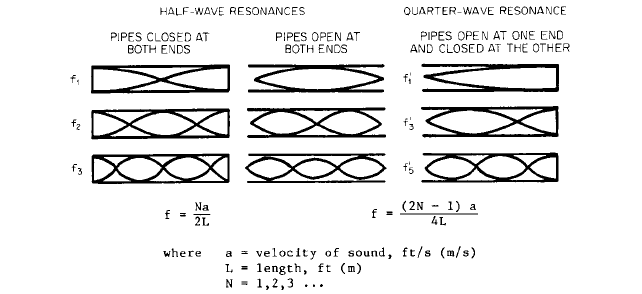
3.64 CHAPTER THREE
FIGURE 1 Organ pipe resonant mode shapes
to determine acceleration head; its value cannot be calculated until these data have been
established. Inadequate NPSH can cause cavitation, the rapid collapse of vapor bubbles,
which can result in a variety of pump problems, including noise, vibration, loss of head and
capacity, and severe erosion of the valves and surfaces in the adjacent inlet areas. To avoid
cavitation of liquid in the pump or piping, the absolute liquid static pressure at pumping
temperatures must always exceed the vapor pressure of the liquid. The pressure at the
pump suction should include sufficient margin to allow for the presence of pulsations as
well as pressure losses due to flow.
Positive Displacement Pump Pulsations The intermittent flow of a liquid through
pump internal valves generates liquid pulsations at integral multiples of the pump oper-
ating speed. For example, a 120-rpm triplex pump generates pulsations at all multiples
of pump speed (2 Hz, 4 Hz, and so on); however, the most significant components will usu-
ally be multiples of the number of plungers (6 Hz, 12 Hz, 18 Hz, and so on). Resultant pul-
sation pressures in the piping system are determined by the interaction of the generated
pulsation spectrum from the pump and the acoustic length resonances of liquid in the pip-
ing. For variable-speed units, the discrete frequency components change in frequency as
a function of operating speed and the measured amplitude of any pulsation harmonic can
vary substantially with changes in the location of the measurement point relative to the
pressure nodes and antinodes of the standing wave pattern.
Piping System Pulsation Response Because acoustic liquid resonances occur in pip-
ing systems of finite length, these resonances will selectively amplify some pulsation fre-
quencies and attenuate others. Resonances of individual piping segments can be
described from organ pipe acoustic theory. The resonant frequencies of standing pressure
waves depend upon the velocity of sound in the liquid being pumped, pipe length, and
end conditions.The equations for calculating these frequencies are shown in Figure 1. All
of the integral multiples (N) of a resonance can occur, and it is desirable to mismatch the
excitation frequencies from any acoustical resonances.A 2:1 diameter increase or greater
would represent an open end for the smaller pipe. Closed valves, pumps, or a 2:1 diame-
ter reduction represent closed ends. For example, a 2-in (51-mm) diameter pipe that con-
nects radially into two 8-in (203-mm) diameter volumes would respond acoustically as an
open-end pipe.
Complex piping system responses depend upon the termination impedances and inter-
action of acoustical resonances and cannot be handled with simplified equations. An elec-
troacoustic analog
1
or digital computer can be used for the more complex systems.
Velocity of Sound in Liquid Piping Systems The acoustic velocity of liquids can be
determined by the following equation:
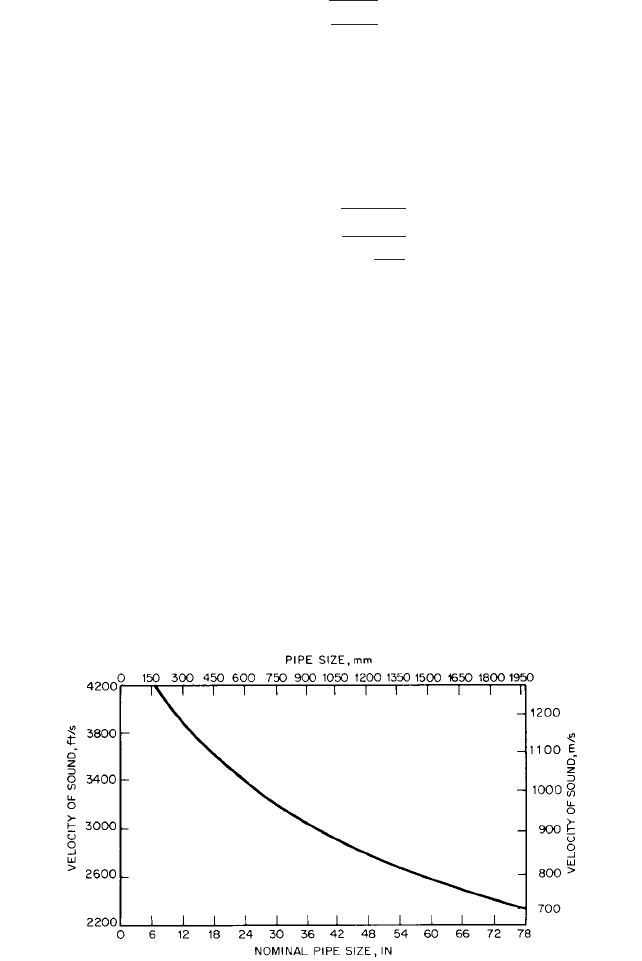
3.4 DISPLACEMENT PUMP PERFORMANCE, INSTRUMENTATION, AND DIAGNOSTICS 3.65
FIGURE 2 Velocity of sound in water at 14.6 lb/in
2
(1 bar), 60°F (15.6°C) versus nominal pipe size with 0.25-in
(6.35-mm) wall thickness
*1 bar 10
5
Pa.
(1)
where a velocity of sound, ft/s (m/s)
C
1
8.615 for USCS units, 1.0 for SI units
K
s
isentropic bulk modulus, lb/in
2
(kPa)
sp. gr. specific gravity
In liquid piping systems, the acoustic velocity can be significantly affected by pipe wall
flexibility. The acoustic velocity can be adjusted by the following equation:
(2)
where D pipe diameter, in (mm)
t pipe wall thickness, in (mm)
E elastic modulus of pipe material, lb/in
2
(kPa)
Pipe wall radial compliance can reduce the velocity of sound in liquid in a pipe as
shown in Figure 2.
2
The bulk modulus of water can be calculated with the following equation
3
for temper-
atures from 0 to 212°F (0 to 100°C) and pressures from 0 to 4.4 10
4
lb/in
2
(0 to 3 kbar*):
(3)
where K
s
isentropic bulk modulus, kbar
K
0
constant from Table 1, kbar
P pressure, kbar
(1 kbar 10
5
kPa 14,700 lb/in
2
)
K
s
K
0
3.4P
a
adjusted
a
R
1
1
DK
s
tE
a C
1
B
K
s
sp. gr.
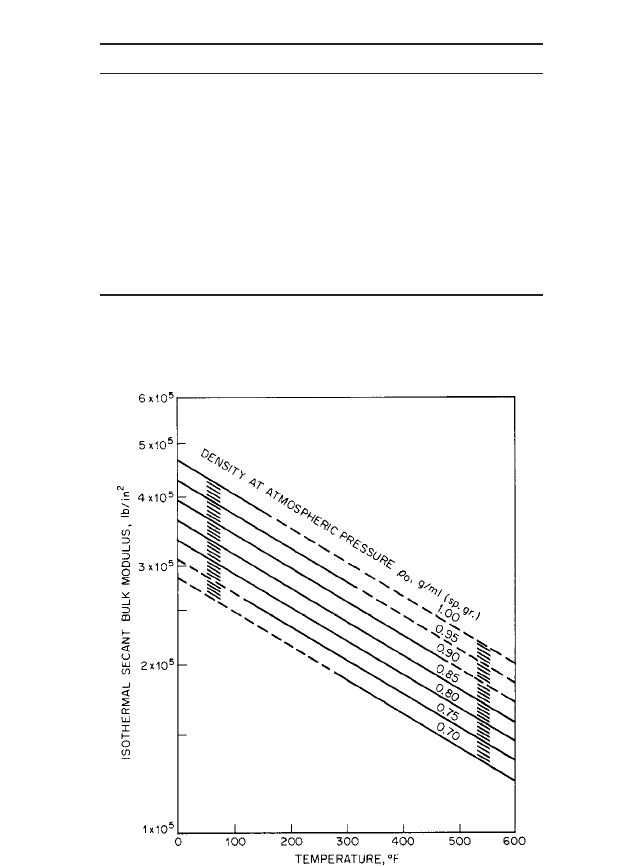
3.66 CHAPTER THREE
TABLE 1 Constant K
0
for evaluation of isentropic bulk
modulus of water from 0 to 3 kbar
Temperature, °C (°F) Isentropic constant K
0
, kbar
a
0 (32) 19.7
10 (50) 21.0
20 (68) 22.0
30 (86) 22.7
40 (104) 23.2
50 (122) 23.5
60 (140) 23.7
70 (158) 23.7
80 (176) 23.5
90 (194) 23.3
100 (212) 22.9
a
1 kbar 14,700 lb/in
2
.
Source: Reference 3.
FIGURE 3 Isothermal secant bulk modulus at 20,000 lb/in
2
gage for petroleum oils
(1 lb/in
2
= 6.895 kPa; °C = (°F 32)/1.8).
The calculation of the isentropic bulk modulus of water is accurate to ;0.5% at 68°F
(20°C) and lower pressures.
4
At elevated pressures (greater than 3 kbar) and temperatures
(greater than 100°C), the error should not exceed ;3%.
The bulk modulus for petroleum oils (hydraulic fluids) can be obtained at various tem-
peratures and pressures by using Figures 3 and 4, which were developed by the American
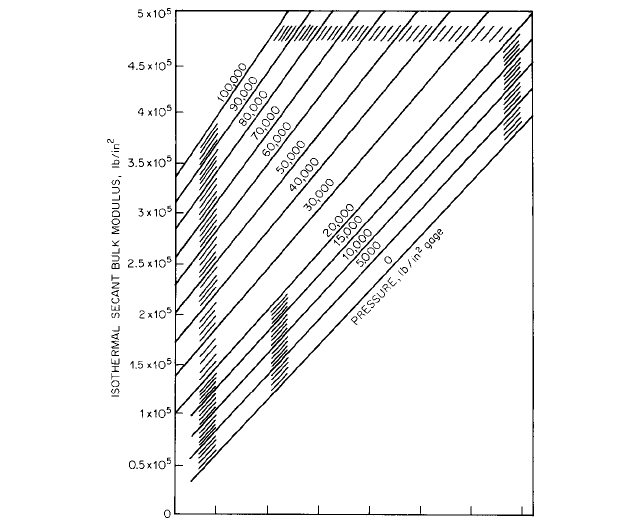
3.4 DISPLACEMENT PUMP PERFORMANCE, INSTRUMENTATION, AND DIAGNOSTICS 3.67
FIGURE 4 Pressure correction for isothermal secant bulk modulus for petroleum oils (1 lb/in
2
= 6.895 kPa)
Petroleum Institute (API).
4
—
7
Figure 3 relates density (mass per unit volume) and temper-
ature to the isothermal secant bulk modulus at 20,000 lb/in
2
(137,900 kPa), and Figure 4
corrects for various pressures.
The isentropic tangent bulk modulus is needed to calculate the speed of sound in
hydraulic fluids and can be readily obtained from Figures 3 and 4 as follows:
1. Read the isothermal secant bulk modulus at the desired temperature from Figure 3.
2. Using the value for isothermal secant bulk modulus obtained from Figure 3, go to Fig-
ure 4 and locate the intersection of the pressure line with that value. Move vertically
to the pressure line representing twice the normal pressure. Read the adjusted
isothermal secant bulk modulus for the double value of pressure.
3. Multiply the adjusted isothermal secant bulk modulus by 1.15 to obtain the value of
the isentropic tangent bulk modulus (compensation for the ratio of specific heats).
The isothermal tangent bulk modulus has been shown to be approximately equal to the
secant bulk modulus at twice the pressure
5
within ;1%.The relationship between isother-
mal bulk modulus K
t
and isentropoic bulk modulus K
s
is
(4)
The value of c
p
/c
v
for most hydraulic fluids is approximately 1.15.
Pulsation Control Pulsation control can be achieved by judicious use of acoustic filters
and side branch accumulators. Acoustic filters are liquid-filled devices consisting of vol-
umes and chokes that use reactive filtering techniques to attenuate pulsations. Side
K
s
K
t
c
p
>c
v

3.68 CHAPTER THREE
FIGURE 5 Two-chamber resonator system with both ends open. V = volume, ft
3
(m
3
); f = resonant frequency, Hz;
L = choke tube length, ft (m); A = choke tube area, ft
2
(m
2
); a = acoustic velocity, ft/s (m/s); m = acoustic parameter.
branch resonators are of two types: quarter-wavelength resonant stubs and gas-charged
accumulators. (The terms accumulators, dampeners, and dampers are used interchange-
ably in the liquid filter industry.)
Acoustic Filters An acoustic filter consisting of two volumes connected by a small-
diameter choke can significantly reduce the transmission of pulsations from the pump into
the suction and discharge piping systems. The equations given in Figure 5 can be used to
calculate the resonant frequency for a simple volume-choke-volume filter. The filter should
be designed to have a resonant frequency no more than one-half the lowest frequency
desired to be reduced, referred to as the cutoff frequency. Such a filter is called a low-pass
filter because it attenuates frequencies above the cutoff frequency.
A special case for symmetric liquid-filled filters can be obtained by choosing equal
chamber and choke lengths. This reduces the equation in Figure 5 to
(5)
where d choke diameter, in (mm)
L chamber and choke length, ft (m)
D chamber diameter, in (mm)
Normally, a good filter design will have a resonant frequency less than one-half the
plunger frequency and will have a minimal pressure drop. For example, a triplex pump
running at 600 rpm generates pulsations at all multiples of 10 Hz. The largest amplitudes
f
ad
p22CD
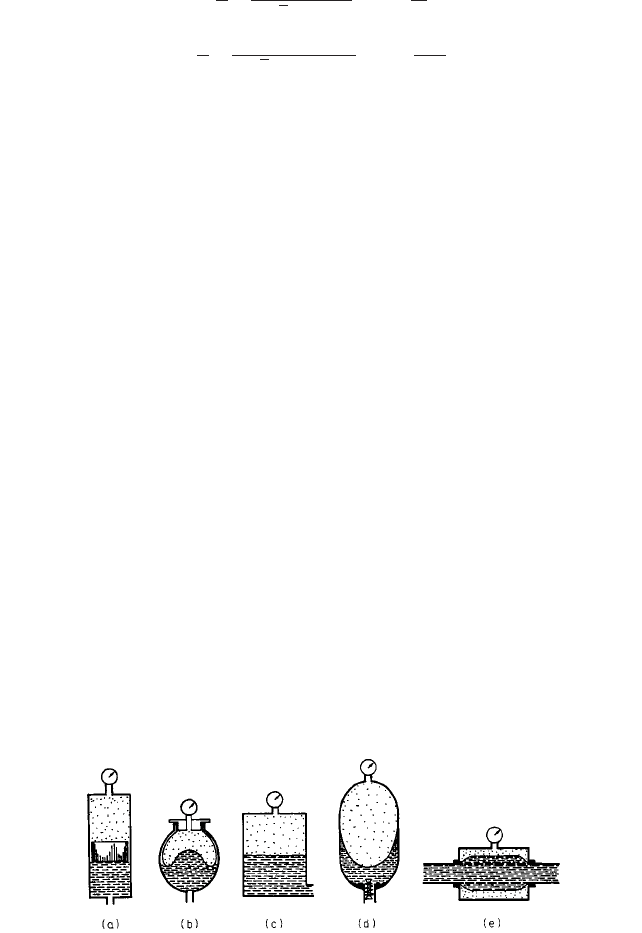
3.4 DISPLACEMENT PUMP PERFORMANCE, INSTRUMENTATION, AND DIAGNOSTICS 3.69
FIGURE 6 Types of accumulators: (a) piston, (b) diaphragm, (c) gas-charged, (d) bladder, (e) in-line
would normally be at 30 Hz, 60 Hz, 90 Hz, and so on.The filter resonant frequency should
be set at 15 Hz or lower. For water, in which the velocity of sound is 3200 ft/s (976 m/s), and
a volume bottle size inner diameter of 19 in (482.6 mm),
in USCS units
in SI units (6)
If the choke diameter is selected to be 1.049 in (26.64 mm), the length of each volume
bottle and choke tube is 2.65 ft (0.81 m). See also Reference 8.
Side Branch Accumulators Liquid-filled, quarter-wavelength, side branch accumula-
tors reduce pulsations in a narrow frequency band and can be effective on constant/speed
positive displacement pumps. However, in variable-speed systems, accumulators with or
without a bladder can be made more effective by partially charging them with a gas (nitro-
gen or air) because the gas charge cushions hydraulic shocks and pulsations. If properly
selected, located, tuned, and charged, a wide variety of accumulators (weight- or spring-
loaded; gas-charged) can be used in positive displacement pump systems to prevent cav-
itation and waterhammer, damp pulsations, and reduce pressure surges.
9,10
Improper
sizing or location can aggravate existing problems or cause additional ones. Typically, the
best location for accumulators is as close to the pump as possible.
Gas-charged dampeners, or accumulators, such as those depicted in Figure 6, are most
commonly used and can be quite effective in controlling pulsations.These devices are com-
mercially available from several sources. Their location and volume and the pressure of
the charge are important to their effectiveness. When gas-charged dampeners are used,
the gas pressure must be monitored and maintained because the gas can be absorbed into
the liquid. The system pressure can sometimes be lower than the gas charging pressure,
such as on start-up; therefore, a valve should be installed to shut off the accumulator dur-
ing start-up to eliminate gas leakage to the primary liquid. When the valve is closed, the
accumulator is decoupled from the system and is not effective.Accumulators with integral
check valves should be adjusted so pressure transients do not close the check valve and
render the accumulator ineffective. Accumulators that have bladders (Figures 6b, d, and
e) to separate the gas charge from the liquid have some distinct advantages, particularly
if gas absorption is a problem. Accumulators with flexible bladders must be carefully
maintained because failure of a bladder could release gas into the liquid system and could
compromise the effectiveness of the dampener.
The in-line gas dampener (refer to Figure 6e) has a cylinder around the pipe contain-
ing a gas volume and bladder. The liquid enters the dampener through small holes in the
circumference of the pipe and impinges upon the bladder, which produces the same
acoustic effect as a side branch configuration.
It is not always possible to design effective pulsation control systems using simplified
techniques. For complicated piping systems with multiple pumps, an electroacoustic
L
d
976
p12 11521482.62
0.03
m
mm
L
d
3200
p12 11521192
2.53
ft
in
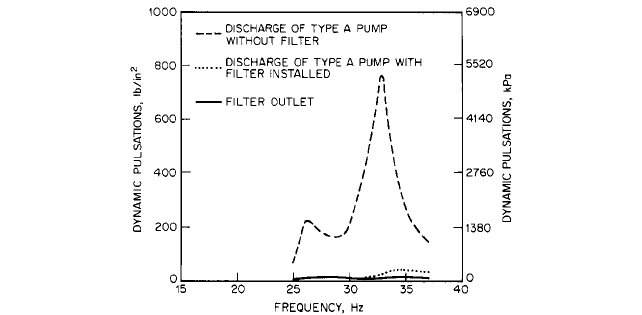
3.70 CHAPTER THREE
FIGURE 7 Effect of acoustic filter on pulsations
analog
1
is recommended for designing optimum filters or accumulators. This tool has
become widely accepted for designing reliable piping systems for reciprocating liquid
pumps and gas compressor units. The reduction in pulsations in a liquid pump system
in a nuclear plant is shown in Figure 7. These results were obtained with a two-volume
acoustic filter system designed with the electroacoustic analog. The volume diameter
was 19.3 in (49 cm), and the length was 4 ft (1.2 m). The choke tube diameter was 0.8 in
(2 cm), and its length was 7 ft (2.1 m). The speed of the triplex (2-cm) pump was 360 rpm,
and the filter resonant frequency was set at 8.1 Hz for a velocity of sound of 4550 ft/s
(1390 m/s).
Piping Vibrations When mechanical resonances are excited by pulsations, vibrations
in the pump and piping can sometimes be 20 times higher than under off-resonant con-
ditions. When the mechanical resonances coincide with the acoustic resonances, an addi-
tional amplification factor as high as 300 can be encountered.
Piping system mechanical natural frequencies can be calculated using simplified design
procedures to provide effective detuning from known excitation sources. A nomogram (see
Figure 8) for calculating the lowest natural frequency of uniform steel piping spans
11
can
be used in designing piping systems and in diagnosing and solving vibration problems. For
example, welded between two bottles, a 4-in (102-mm) pipe that is 10 ft (3 m) long and has
an inner diameter of 3.826 in (97.18 mm) would have a mechanical frequency of 74 Hz. If
the pipe was an equal-leg L bend (L 5), the natural frequency would be 50 Hz.
To minimize piping vibration problems, all unnecessary bends (considering routing and
thermal flexibility) should be eliminated because they provide a strong coupling point
between pulsation excitation forces and the mechanical system. When bends are needed,
use the largest enclosed angle possible and locate restraints near each bend. Piping should
also have supports near all piping size reductions and at large masses (valves, accumula-
tors, flanges, and so on). Small auxiliary piping connections (vents, drains, pressure test
connections, and so on) should be designed so the mass of the valve and flange is effectively
tied back to the main piping, thus eliminating relative vibration.
Diagnostics and Instrumentation The diagnosis of vibrations in positive displacement
pumps should usually include dynamic pressure measurements in the cylinders and pip-
ing near the pump. These measurements can be obtained by the use of piezoelectric or
strain gage pressure transducers. If cavitation or flashing is suspected, a pressure trans-
ducer capable of measuring static and large dynamic pressures should be used; even then,
cavitation-produced pressure shocks may damage the transducer.
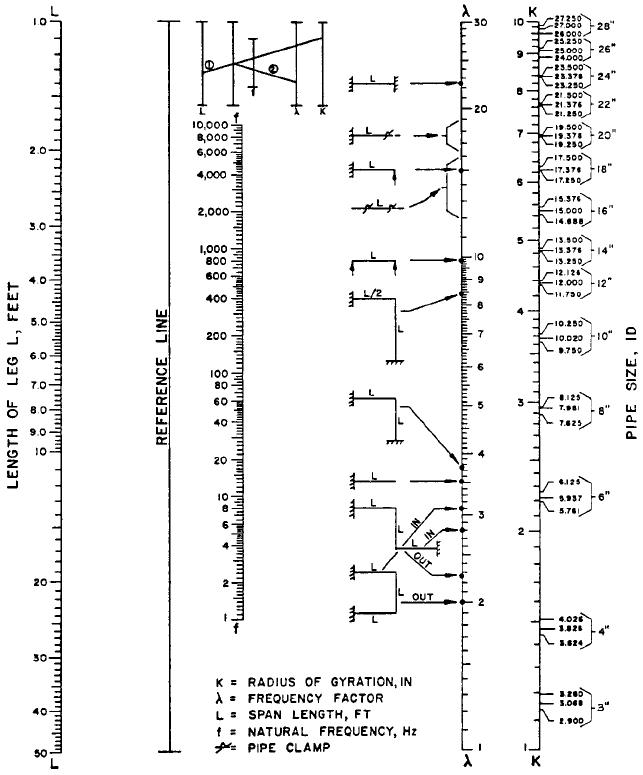
3.4 DISPLACEMENT PUMP PERFORMANCE, INSTRUMENTATION, AND DIAGNOSTICS 3.71
FIGURE 8 Natural frequency of uniform steel piping spans (1 ft = 0.3048 m; 1 in = 2.54 cm)
Accelerometers with low frequency characteristics may be used with electronic inte-
grators to obtain accurate vibration displacement data from the pump case, cylinders, or
piping. Similarly, velocity or seismic pickups may be employed. Maximum vibrations usu-
ally occur at the middle of piping spans and at unsupported elbows (out of plane).
Real-time analyzers and oscilloscopes may be used to display the resulting signals. A
field example showing the diagnosis of cavitation at the pump suction using a strain gage
diaphragm pressure transducer is given in the oscilloscope trace of Figure 9. The vapor
pressure (gage) for this system was 25 lb/in
2
(172 kPa). Note that the negative half of the
cycle is flattened when vapor pressure is reached and that very high amplitude pressure
spikes are apparent. For liquids with dissolved gases, lower pulsation amplitudes can pro-
duce cavitation; however, the cavitation is usually less severe.
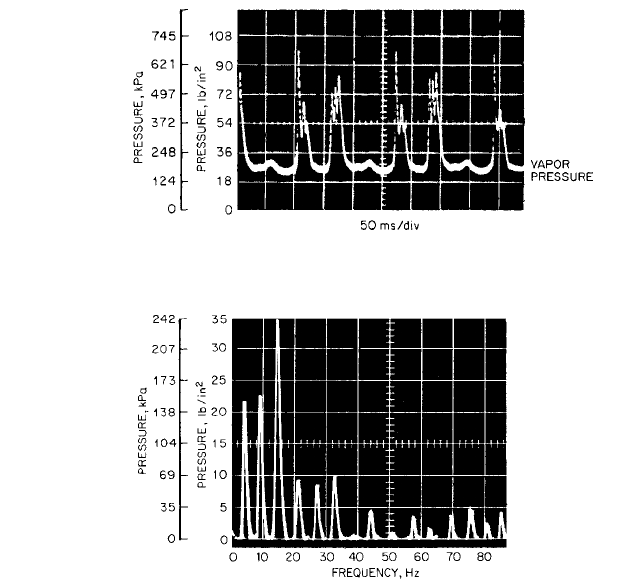
3.72 CHAPTER THREE
FIGURE 9 Complex wave data showing cavitation effects of pressure wave in a liquid piping system
FIGURE 10 Typical field data recorded on a three-plunger pump
Typical field pulsation data obtained on a three-plunger pump is shown in Figure 10,
which is a frequency spectrum of the pulsations made by a real-time analyzer. Each spike
represents a frequency multiple of running speed. Note that the third spike, representing
the plunger frequency, has the largest amplitude; however, the components at one and two
times pump speed are also significant, which means that these frequency components
should be considered for pulsation control.
The vibration frequencies of the piping should be compared with pulsation frequencies
to evaluate potential pulsation excitation of mechanical resonances. A check of the piping
mechanical natural frequencies from the nomogram (refer to Figure 8) should be made to
evaluate the possibility of a mechanical resonance. High vibrations produced by low-level
pulsations at a particular frequency are indicative of a mechanical resonance, which can
usually be corrected by additional piping restraints or snubbers. After the causes of the
pulsations and vibrations are diagnosed, the techniques presented previously can be used
to develop solutions.
Thermal Problems In pump systems with high thermal gradients, large forces and
moments on the pump case can cause misalignment of the pump and its driver as well
as pump case distortion resulting in vibrations, rubbing (wear), bearing failure, seal leak-
age, and so on. High stresses can be imposed on the piping, resulting in local yielding or
damage to the piping restraints, snubbers, or support system. Misalignment problems
commonly exhibit a high second-order component of the shaft vibrations. Proximity
